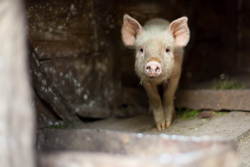Diversity database helps conserve rare pig breeds
Preservation of genetic resources is high on the agenda for ecologists and geneticists alike. The thrust for biodiversity is not solely confined to academic circles however. For example, the conservation of rare animal breeds has gained strength through the activity of traditional meat marketing companies. Committed to organising the promotion of the highest quality meat from pedigree British traditional breeds, they are helping to maintain rare genotypes. Members of the EU funded project PIGBIODIV2 obtained genetic resources from both Chinese and European pig breeds for comparison. Indigenous Chinese breeds are recognised as an invaluable component of the world's pig genetic resources and so provided a useful barometer of diversity in European stocks. Maximising the resources collected during the project, consortium members based at the Roslin Institute in Scotland compiled a European pig diversity database. Large White and Landrace, accounting for some 60% of the total sow herd in Europe were included amongst rarer breeds. The European wild boar, although not endangered is represented as the origin of the domestic pig. The compilation of the library involved the latest genomic technologies. The core of the database consists of microsatellite markers, invaluable for studies of genetic variation. Through amplification using the polymerase chain reaction and high-resolution polyacrylamide gel electrophoresis, the variation in the number of repeats within the microsatellites was determined. Pooled allele frequencies for microsatellite markers and over 1,300 single nucleotide polymorphisms are also available through the database. This database will help to conserve rarer breeds under particular threat from disease because of small population numbers. Large scale producers stand to benefit with improved meat yields and flavour. At the other end of the scale are cottage industries such as Parma ham producers that depend on certain genotypes. The discerning customer can not only demand tasty meat but can help to power the academic drive for conservation.

